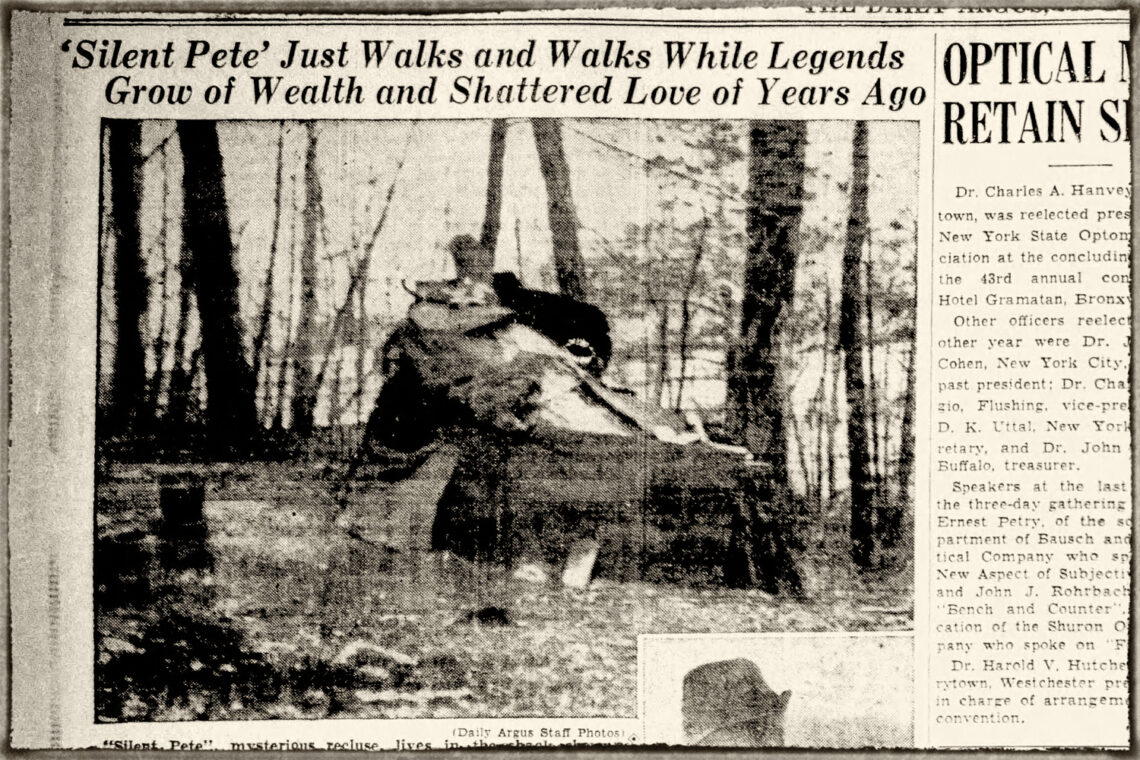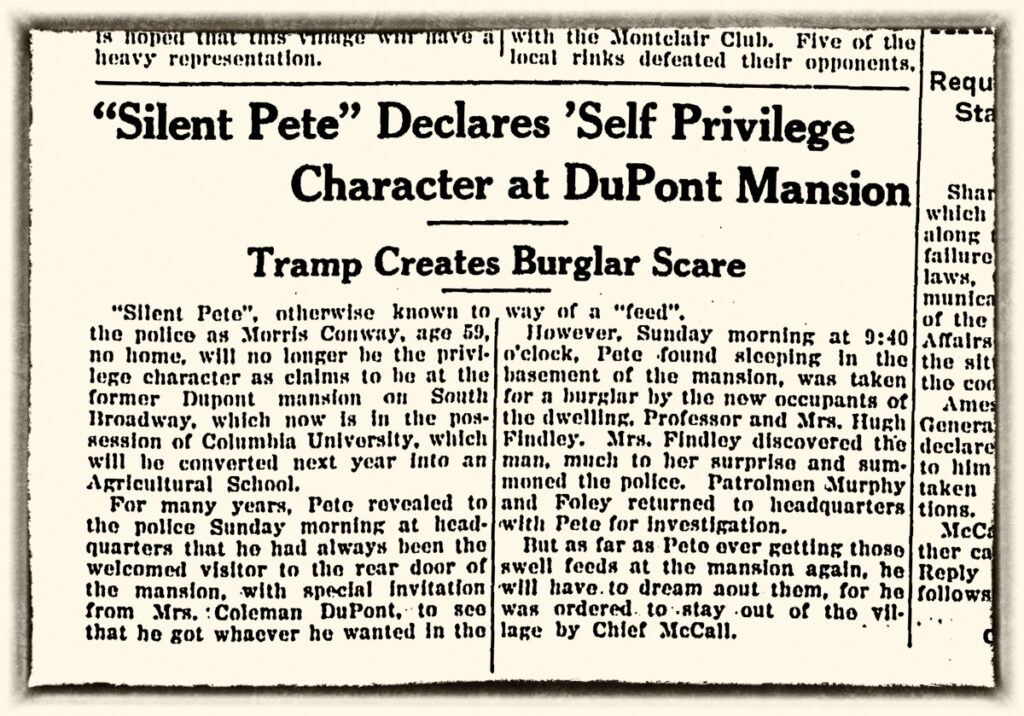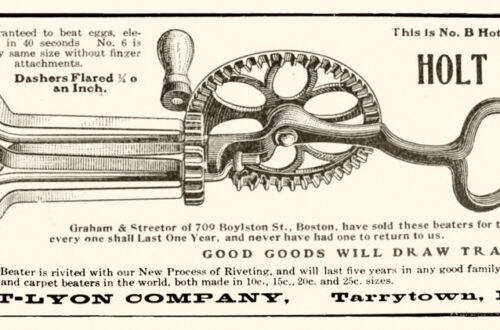
The Lonely Life of Silent Pete
“For nearly 20 years—as far as anyone knows—a shabby, slouching figure of a man has been walking daily between Yonkers and North Tarrytown, creating for Hudson Valley residents a new legend. He never speaks: so he’s called Silent Pete. Iron Mike and Nothing Joe. He just walks.”
The Tarrytown Daily News, Tarrytown, NY. May 19, 1938.
Tarrytown and North Tarrytown (today’s Sleepy Hollow) were once the haunts of Silent Pete, a reclusive and mysterious character who walked a regular route along the river towns in southern Westchester County.
Reclusive and mysterious characters aren’t in short supply in Sleepy Hollow Country. In fact, Silent Pete picked up the mantle from two earlier local recluses. The most renowned was the Leatherman, who from 1857 to 1889 walked an annual 365 mile clockwise loop through Westchester and Fairfield counties. Irvington had its hermit who lived in an isolated cabin, sleeping in his own hand-made coffin in the years before his death in 1888.
Silent Pete, although lesser known today than the Leatherman or Irvington hermit, unwittingly created a legend during his own time. Throughout the 1920s and 1930s Pete was reported to walk daily from his Hastings-on-Hudson encampment to North Tarrytown, a distance of about 12 miles. Some say he would only walk on the west side of the road, for reasons unknown. Why he walked and where he stopped along the way became the subject of wild speculation and eventually local legend, culminating in a 1938 series of articles in newspapers throughout the county.
“Silent Pete walks unevenly but rapidly. He keeps his eyes glued to the ground and his hands in the pockets of his brown overcoat. He has gray, piercing eyes, a stubby gray beard and shaggy hair covered with an old brown slouch hat. His trousers are black, his shoes worn.”
The Herald Statesman, Yonkers, NY. May 19, 1938.
His travels were not always without incident. Walking in the roadway of Warburton Avenue in the the business district of Hastings-on-Hudson around dusk on the evening of December 9, 1931 he was struck and knocked down by an automobile. He was taken to St. John’s Riverside Hospital in Yonkers for treatment of abrasions to the head.
Contents
Silent Pete’s Shack
Silent Pete lived in ramshackle hut in the village of Hastings-on-Hudson just north of the Yonkers border. Some reports place his shack between the east side of Warburton Avenue and the Croton Aqueduct, others situate it a little further east just off the Albany Post Road near the Graham School.
“His shack is a hodgepodge of tarpaper strips, wood, tin, and an old brown blanket over the low doorway. The hut is in the center of a sparse clump of trees and refuse strewn underbrush, north of the Graham School property in Hastings. Smoke curls out of a rusty chimney, rising from a cracking fire in an old stove inside.”
The Herald Statesman, Yonkers, N.Y., May 19, 1938.
No matter the exact location it was, as The Herald Statesman described, a crude shelter made of wood, tin and tarpaper strips with an old brown blanket for a door. Inside was a salvaged wood stove which was apparently the shack’s only comfort. This humble abode was hidden from the road in a clump of trees. The surrounding underbrush was littered with old tin cans. An old tub was nearby for occasional bathing.
Believed to Be Rich
In a May 19, 1938 article The Tarrytown Daily News quoted Tom Matthews of Dobbs Ferry: “I hear he’s rich, all right. I hear he came from a pretty rich family and when his father died he was left part of the fortune. But his brother and sister took his dough; so now he walks back and forth—maybe in front of their place.”
In the same article a Tarrytown counterman offered a competing theory. “He’s supposed to have been rich once, anyway. From what I hear, and I’ve been around for 12 years now, he was in love with some very rich girl on one of these estates up this way. Must have been 20 or 25 years ago. She’s supposed to have thrown him over—so he’s been getting back at her by walking up an down past the estate of her husband.”
Silent Pete Sleeps in a Cemetery Cave
Oscar Peterson, a coal dealer, was quoted in the May 19, 1938 Mount Vernon Argus “I understand he’s supposed to have a cave or something up at Sleepy Hollow Cemetery, But I’ve seen him take a bath at his hut. It was a cold day a couple weeks ago and he just put some water in an old tub and got in. Gee, it was cold!”
Cemetery directors repeatedly denied the existence of a cave, but a former Tarrytown volunteer fire fighter corroborated its existence and use by Silent Pete.
Mrs. Findlay Surprises Silent Pete
On occasion Pete would benefit from the generosity of households along his route. Alice Elsie du Pont was one notable example, apparently instructing her household staff to give Pete whatever he wanted in the way of a “feed”. Alice and her husband Thomas Coleman du Pont, a senator from Delaware and heir to the du Pont fortune, had purchased the Nevis estate in Irvington in 1920 just about the time Pete seems to have started his daily walks from Hastings-on-Hudson to North Tarrytown.
After Thomas died in 1930 Alice held onto the estate for four years before donating it to Columbia University. The university installed Professor Hugh Findlay, associate professor of landscape architecture, on the estate to develop an arboretum and gardens. Unaware of the change in situation, Silent Pete was discovered by Mrs. Findlay napping in the basement of the house the morning of Sunday, September 9, 1935. Hauled into Irvington village court by patrolmen Murphy and Foley, Silent Pete was revealed to be 59-year-old Morris Conway.

Silent Pete Identified
As Morris Conway, Silent Pete first appeared in the local news in September 1904 when The Yonkers Herald reported he was charged “with being a tramp” and sentenced to 30 days in jail. In April 1906 competing newspaper The Yonkers Statesman reported that Conway, aged 32, was picked up on Nepperhan Avenue for vagrancy and sentenced to another 30 days in jail.
Perhaps seeking a friendlier locale, Conway appears to have shifted his base of operation three or four miles east to the village of Bronxville where in August of 1913 Captain Van Buren of the Bronxville police brought him before Judge O’Neill on charges of vagrancy. The Bronxville Review quipped “The Judge thought five days meditation might help Conway’s case, which is a chronic one.” A competing daily, The Bronxville News, perhaps alluding to rumors of secret wealth, tartly commented “Morris Conway, vagrant, was given five days at White Plains, by Justice O’Neill. There were no lobster-newburgs served to Morris.” Apparently five days “meditating” in the county jail did nothing to cure Conway.
Repeated harassment in Bronxville may have contributed to his moving west again to the friendlier villages along the Hudson River, settling a few feet north of the Yonkers city limits—and out of reach of the Yonkers police. Indeed, the villages from Hastings-on-Hudson to North Tarrytown appear to have been more accepting of the mysterious Silent Pete.
In May 1938 The Tarrytown Daily News quoted an unidentified Tarrytown police officer: “You know we don’t pick him up because we never see him panhandle or anything. He never says a word when folks who have seen him for a long time try to stop and help him. He moves on. I been wondering if maybe some of those stories about him are true.”
The same newspaper went on to report that “Despite his apparent, poverty, the man is honest, according to Chief of Police Daniel F. Murphy, who has occasionally forced him, with much reluctance, to accept the price of a meal.” Once, Silent Pete turned over to Chief Murphy a purse containing a driver license, keys and some cash. The newspaper reported “He told Chief Murphy he found the purse on South Broadway on Gould’s Hill and asked him to find the owner. Murphy traced through the license and found the owner to be an up-state school teacher who had been engaged for the Irvington High School. The teacher left a reward for the finder, who reluctantly accepted it.”
Appropriately, after Silent Pete’s brush with local fame in 1938 he seems to have slipped back into the shadows as he probably preferred. No record of his death seems to have been published, and despite his alleged secret cave in Sleepy Hollow Cemetery there is no record of Morris Conway buried there.




